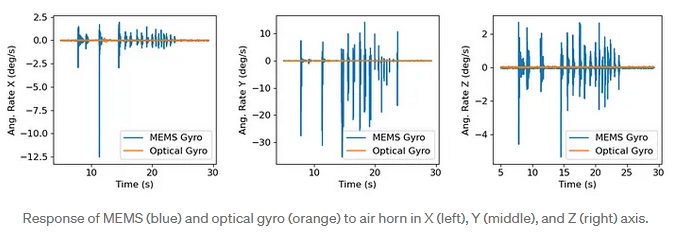Silence is Golden: How Optical Gyroscopes Navigate Noisy Environments
ANELLO Photonics is bringing optical gyroscope technology to the mass market using silicon photonics. Our silicon photonic optical gyro (SiPhOG™) not only provides an order of magnitude performance improvement over typical MEMS sensors, it also boasts superior immunity to environmental effects such as temperature, vibrations, and acoustics.
This blog showcases a simple analysis on the acoustic sensitivity of MEMS vs optical gyros, and the potential implications in autonomous navigation.
Acoustic Response of MEMS and Optical Gyroscopes
ANELLO recently announced the X3, the world's smallest 3-axis optical gyroscope-based IMU, for environments with heavy dynamics such as aerial and maritime applications. The X3 contains three SiPhOGs (one for each axis), which were used as the optical gyroscopes in this test. For the MEMS gyroscopes, we used an automotive-grade ST Micro MEMS IMU.
We conducted a simple experiment: we simultaneously measured the MEMS gyro and our SiPhOG™ in response to an air horn, which produces sound on the order of 100–120 dB. The results were striking.
MEMS gyro (blue): Spikes in the output signal of up to 38 deg/s were observed at each air horn instance, indicating a strong reaction to acoustic disturbance.
SiPhOG (orange): The output signal remained unchanged, demonstrating immunity to the acoustic disturbance.
To understand the implications of this response, we integrate the rate measurements into relative angles. Take for example the Y axis, in which the MEMS gyro showed the harshest response to the air horn. Integrating the angular rate reveals that the acoustic sensitivity of the MEMS gyroscope results in over 10 degrees of error! These magnitudes of errors can have disastrous effects on autonomous navigation solutions using MEMS-based IMUs as part of its sensor fusion engine.
Why Are MEMS More Sensitive to Sound?
MEMS gyroscopes sense angular rate using the Coriolis effect, which says that a vibrating mass experiences an additional force when the device is rotating. However, MEMS devices also experience inherent microscopic vibrations, known as Brownian motion, which they need to differentiate from actual rotation. This becomes problematic when acoustic disturbances (like sound waves) cause additional vibrations which can resonate with the MEMS structures. This amplified vibration can then be misinterpreted by the gyroscope as an actual rotation, leading to inaccuracies in its readings, particularly in noisy environments.
On the other hand, optical gyroscopes sense rotation by passing light in both directions around a fiber coil, and measuring the phase shift of light caused by rotation. This is known as the Sagnac effect, and the process is unaffected by acoustic vibrations. The SiPhOG takes the same concept of a fiber-optic gyro and miniaturizes it onto a chip using silicon photonics. This enables the same high performance and superior immunity to environmental effects as optical gyroscopes, while its smaller size, weight and power open the door for mass-market applications that weren’t previously possible with optical gyros.
How Acoustic Sensitivity Affects Autonomous Systems
Autonomous systems rely on precise IMU data for their navigation, particularly in areas where GPS signal is lost. The observed acoustic response from MEMS gyroscopes can have significant implications across various applications:
Aerial vehicles: Wind and engine noise from drones, jets, or rockets can cause acoustic disturbances on the order of 160+ dB, which could disrupt flight control and autonomous navigation.
Automotive: Acoustic disturbances from horns, sirens, and construction zones (110+ dB) can disrupt navigation accuracy and impact safety.
Agriculture: Engine noise and rattling of tractor attachments can introduce acoustic disturbances of 120+ dB, leading to errors in guidance systems.
Mining: Drilling, controlled explosions, alarms, and heavy machinery noise (120–160 dB) can compromise accurate positioning and orientation data, crucial for safe operations.
Conclusion
For MEMS gyroscopes, sensitivity to environmental factors such as acoustics can be a significant drawback in applications requiring high precision and reliability. These effects are typically not presented on datasheets. On the other hand, optical gyroscopes like ANELLO’s SiPhOG™ provide superior accuracy and immunity to environmental effects, making them compelling for next-generation autonomous systems that require reliable performance in a wide range of harsh environments.
To learn more about how ANELLO’s technology can help solve your navigation needs, get in touch with us at info@anellophotonics.com.
ANELLO seeks to drive a new revolution in inertial sensing with optical gyros using silicon photonics, which will allow many more applications to experience the optical gyroscope’s exquisite performance.



